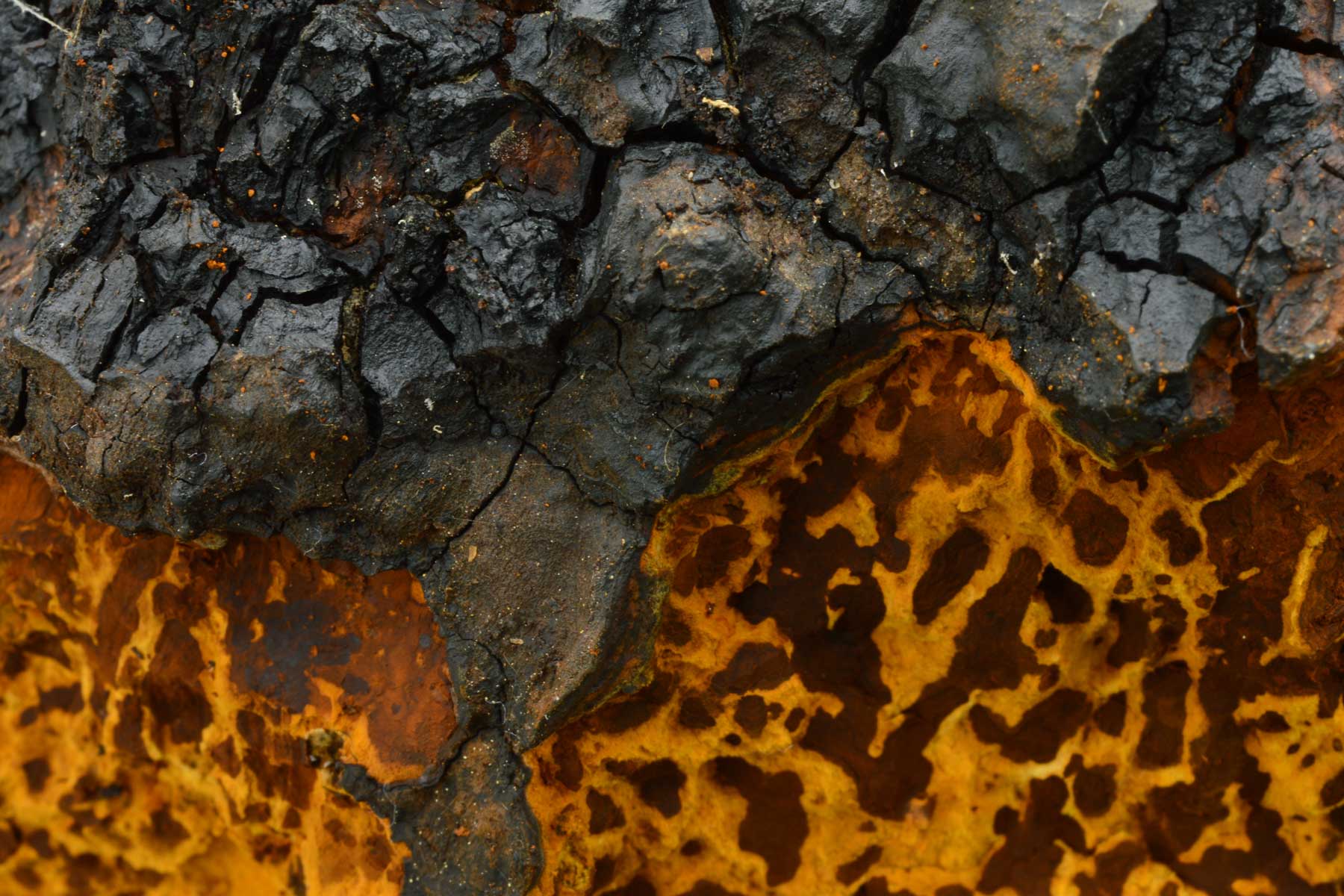If you’ve ever walked by a tree with white bark and wondered why someone would stick a well-cooked, round brisket on it… Or maybe you’ve noticed a giant chunk of burnt-to-a-crisp tree that seems out of place.
Whatever you think it looks like, the hard, charcoal black exterior is a dead giveaway you’ve found one of Nature’s treasures – the chaga mushroom.
When pried off the tree and cut up, the dark orange flesh is revealed. Hidden within are nutrients and beneficial compounds that have caused some to dub it “the king of medicinal mushrooms”. There are some good reasons for that.
How to identify a chaga mushroom
If you’re able to find them in the wild, consider yourself lucky.
First, you’ll have to be somewhere cold in the northern hemisphere. Chaga mushrooms love the colder climate found in Siberia, Russia, Northern Europe, Canada, and Alaska.
Chaga mushrooms grow on a few different trees, but there’s only one you should care about – the birch tree. Look for its characteristic white bark to eliminate a good chunk of forest if you’re hunting mushrooms.
Just like everything else, chaga mushrooms are what they eat. The compounds and nutrients you’re really looking for can only come from birch trees. Other nature-found mushrooms are just inferior.
The health benefits of chaga mushrooms
Scientific research is ongoing. Science hasn’t quite caught onto what our ancestors have known about this superfood for hundreds of years. It’s typically drunk as a tea. Though it has a taste that’s similar to coffee, it has no caffeine.
That said, there’s no shortage of benefits – no shortage of reasons you should be taking this incredible fungus every single day.
Immune system support
Earlier, you found out your chagas should come from birch trees. There’s a secret hiding in their bark that just isn’t found in other trees.
While chaga mushrooms are breaking down the dead wood, they create special polysaccharides. They’re the heart of chaga’s immune-supporting benefits.
Perhaps most importantly, chaga mushrooms help keep your immune system’s inflammation response in check.
Mushrooms also contain fiber which can act as a prebiotic to feed the “good” bacteria (probiotics) in your gut. Your gut, and largely probiotics, form roughly 70% of your immune system. So anything you can to help the good guys out is a good thing.
Fights free radicals
Chaga mushrooms have been shown in several studies to be able to fight – and quench – free radicals. Free radicals are something your body produces as byproducts. They’re entirely normal, but they’re also produced as a result of environmental pollution, pesticides, and smoking.
Over time, free radicals are capable of affecting your health in the exact opposite way you want it to go. A phenol-rich mushroom like chaga can fight these free radicals and neutralize them.
Blood sugar support
Though human studies are currently lacking, it’s clear from several studies that chaga mushrooms have the ability to support blood sugar levels already in the normal range.
The polysaccharides (fiber) are once again, a great help here. As a general rule, fiber will help maintain your blood sugar. Chaga mushrooms go above and beyond normal fiber. In a study on rats, scientists discovered chaga’s fiber and antioxidants work together.
Lab-grown chaga mushrooms
A lot of emphasis has been placed on chaga mushrooms that grow naturally on birch trees. If you’re out hunting in the wild, that’s what you need to do. But don’t let that keep you from buying a high-quality supplement. The keyword being “high-quality.”
In the lab, chaga isn’t grown on bits of dead or dying birch tree. Mushrooms can be grown on oats, straw, wood, compost, etc.
There are basically two things to ask before you buy lab-cultivated mushrooms.
- Get a nutrient profile if you can. You’ll have an idea of the benefits you can get.
- Find out how much of the final product is substrate vs mycelium or fruiting body. Obviously, the less substrate, the better.
Keep in mind, a lab can control the nutrients a lot better than Nature can. Wild-harvested mushrooms are subject to the elements – heat, wind, rain, sunshine, what the mushroom is eating. You’ve got a Forrest Gump situation here. You never know what you’re gonna get.
_______________
Sources
https://www.ncbi.nlm.nih.gov/pmc/articles/PMC4946216/
https://www.medicalnewstoday.com/articles/318527.php
http://agris.fao.org/agris-search/search.do?recordID=KR2007000481
https://www.ncbi.nlm.nih.gov/pmc/articles/PMC5618583/
https://www.ncbi.nlm.nih.gov/pmc/articles/PMC4100277/








Leave a comment